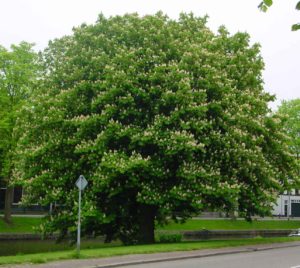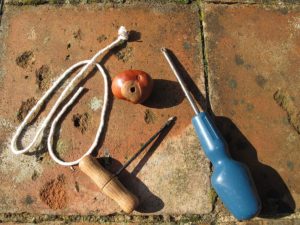 Did you know that in Britain, the second Sunday in October is “National Conkers Day”?? Yes, yesterday you should have pulled out your best hardened-up horse chestnut on a string and challenged some other conker player to a match. What, you didn’t know? Well, I confess I didn’t either until I ran across this factoid while doing research for my current revisions.
Did you know that in Britain, the second Sunday in October is “National Conkers Day”?? Yes, yesterday you should have pulled out your best hardened-up horse chestnut on a string and challenged some other conker player to a match. What, you didn’t know? Well, I confess I didn’t either until I ran across this factoid while doing research for my current revisions.
So, this time it started because my heroine needed to climb a tree. Not just any tree, but a big old one, tall with spreading branches that would be stout enough for the job –not to mention that earlier in the story a cheetah needed to perch on one of said stout branches of the same tree.  (I do know that cheetahs don’t climb trees. You’ll need to read the story –The Magnificent Marquess wasn’t originally and in the new version still won’t be your standard Regency romance.)
(I do know that cheetahs don’t climb trees. You’ll need to read the story –The Magnificent Marquess wasn’t originally and in the new version still won’t be your standard Regency romance.)
I thought a horse chestnut ought to do the trick, and they are common in Great Britain in modern times, but –I was pretty sure they aren’t native to Britain. So first thing to check: when were they introduced? Second thing to check: how big can they grow?
I’ve learned that in doing research, assumptions are the biggest stumbling-block (and often the hardest thing to recognize!). That’s where the conkers come back in. I found the info I needed (trees introduced from Persia/Turkey/the Balkans in the 16th century, can grow to 100 feet high). I thought about having children in the story engage in playing conkers since the tree was there.
Have you ever played conkers? I haven’t –but my husband says he did in his youth. I was aware of it as a thing people (mostly boys) used to do, and I assumed that conkers was a game well-venerated through the ages, human nature being what it is. And actually, it is. Just not with horse chestnuts.
It seems, at least according to the sources I saw, that in earlier times conkers was played with snail shells, cobnuts, even stones, but conkers with horse chestnuts (they claim) is 20th century. I also saw the date 1848 given in several sources as the year of the first recorded conkers game, on the Isle of Wight. Victorian, and not with horse chestnuts, apparently. Now the World Conker Championships are held in Northamptonshire on the second Sunday in October every year.
 It would take some more digging to verify if the sources I saw were actually correct. I did not take the time to look further. Too many rabbit holes out there, and time is always short. Who could prove they were the first person ever to put a horse chestnut on a string? I am not convinced that it was not being done during the Regency, or earlier, but it was also not important for my story. The point is the surprise. So often things I assume are old enough to be Regency turn out not to be. This is just one example.
It would take some more digging to verify if the sources I saw were actually correct. I did not take the time to look further. Too many rabbit holes out there, and time is always short. Who could prove they were the first person ever to put a horse chestnut on a string? I am not convinced that it was not being done during the Regency, or earlier, but it was also not important for my story. The point is the surprise. So often things I assume are old enough to be Regency turn out not to be. This is just one example.
I love doing research, and I do a lot of it. I like to think my stories “could have happened” even though I made them up. But the hardest part of doing story research isn’t finding the information –it’s figuring out what bits you need to check!
Of course, in the end, the story is what matters most. And all of us story-tellers hope that when the reader is engaged deeply enough, any glitches we missed won’t matter. What research pitfalls have you encountered, as a writer or a reader? If I had tripped over this one, would you have known, or cared?



How funny, Gail! I wanted the boys in my Christmas novella, A Perfectly Unregimented Christmas to play conkers, but I had to settle for marbles as my sources also said they didn’t play conkers during the Regency.
I, on the other hand, have played conkers, as have my two brothers. When we lived in England playing conkers was one of the ways we integrated ourselves into life in the little village where we lived. It has been over forty years but my brothers and I still talk about playing conkers. I know some of our champion conkers made it back across the pond, but I have no idea where they might be now. Long gone, I am certain.
I recently researched trees as well as I wanted a tree-lined drive and didn’t want the usual oaks or ash or beechnuts. I wanted something to remind the hero of a cemetery and the drive to be on a very old estate. Something along the lines of why hadn’t their friend chosen better trees to line his drive and the answer being the trees were planted by some long ago Norman relative. Yew trees, once I researched them. served the purpose quite nicely.
Louisa, that IS funny –it’s such a specific thing! Somehow I am not at all surprised to hear you played conkers along with your brothers during your time in England, though. And good job on the yew trees choice. Those are one variety of tree that I could believe would still be alive after that many centuries –I’ve seen yews in England that were that old. Ah, the things we have to do for our stories! Thanks for dropping in!
I wouldn’t have had an issue with conkers (1848 is a bit far out for a recorded instance, but certainly someone might have come up with the idea earlier) but I appreciate you and Louisa being meticulous about it.
You’re right, it’s the things you think you know that can be the trickiest. I wrote my first waltz scenes before I knew that it was danced differently during the Regency, although I didn’t write in enough detail to be very far off. No one has complained. Actually the only reader (so far) who complained about accuracy was the one who said women didn’t do THAT during the Regency. But I’m pretty sure they did, because Victorians. 🙂
LOL, Elena. Yes indeed, if women didn’t do THAT, the human race would have ended… 🙂